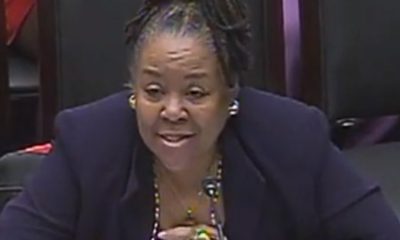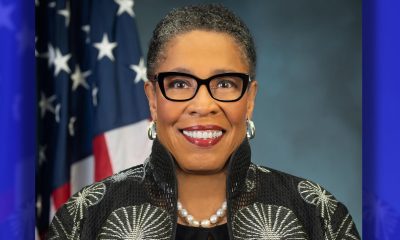Black History
Opera and the African American – ‘Figaro Meets Frederick Douglass’
NNPA NEWSWIRE — “Our artistry is vast, and can be used in many ways, but without funding for creating new stories with casting of old stories in collaboration with advertising and marketing, one might think Black people never existed or have a place to shine in opera, which causes another challenge.”
By Stacy M. Brown, NNPA Newswire Correspondent
@StacyBrownMedia
Among many other trailblazing accomplishments, W.E.B. Du Bois stood among the many African Americans who composed, sang, and otherwise reveled in opera.
In 1955, Marian Anderson broke the color barrier at the Met. Yes, Blacks in opera – it’s a thing.
Opera is as much a part of the African American as Rhythm & Blues. It just hasn’t always been as celebrated, according to historians.
Consider, 19th century black singers like Elizabeth Taylor Greenfield and Sissieretta Jones sang opera but reportedly gave recitals because the opera houses refused to hire them.
Black churches were performing Verdi’s Requiem with all-Black casts and musicians. Coretta Scott King attended the New England Conservatory, planning to be an opera singer, according to Hyperallergic, a web forum for serious, playful and radical thinking about art.
Officials at the Coalition for African Americans in the Performing Arts – or CAAPA – said they’re dedicated to “Bringing Color to the Classics.” The organization advocates for diversity on the stage on behalf of Black classical musicians, youth and others in the performing arts.
Through the nonprofit organization’s newly formed International Outreach Program, CAAPA provides a vibrant musical experience, bringing culturally diverse performance opportunities to the community and underserved population while promoting Black classical musicians and others in the performing arts.
The International Outreach Program offers concerts, recitals, festivals, panels, workshops, exchanges, musical performances, and more. The program will also target diverse populations in elementary, middle and high schools, camps, youth programs, as well as adult audiences, including seniors.
Officials hope the program will help overcome the radical racial barriers that have long kept Blacks out of the opera. “Like any other professional field or industry, there is always racial bias. However, it has gotten moderately better in past years,” said Terri Allen, the executive director of CAAPA.
For instance, Allen said when CAAPA began in 2003, only 3 percent of all opera companies and symphony orchestras had main stage roles for Black musicians.
Today, that total has risen by almost 5 percent – much of it can be attributed to the work that CAAPA has done on behalf of Black classical musicians. “While overall, it has gotten better, these challenges allow us to continue creating spaces for ourselves to tell our stories, as well as other stories that may not always look like us, while adding our perspective and artistry along the side of our colleagues who are not Black,” Allen said.
CAAPA is very aggressive in this regard.
“We deliberately create performance opportunities for Blacks. For instance, this season’s performance roster includes programs such as, ‘Figaro Meets Frederick Douglass’; ‘Musical Tribute to Shirley Chisholm’; and ‘Cotton Field to Concert Hall,’” Allen said.
Among the continued challenges is recognition of the seemingly endless pool of Black talent.
“CAAPA would love to have Black artists be seen and provided with an opportunity to shine purely based on skill and talent with consideration for casting and being matched alongside any other artist regardless of skin color, height, or weight,” Allen said.
“Often times, it is not what you know, it is who you know, when chosen for an opera. In some cases, plots in opera require a distinct ethnicity of a character to help further tell the story and assist with visually displaying the obstacle, while other operas can be more daring in casting.”
Allen continued:
“One opera even [literally] states the ethnicity of its characters. Representation is important and educates many who believe that opera is not a place for a Black person while exposing the existence of Black people already in opera.
“Our artistry is vast, and can be used in many ways, but without funding for creating new stories with casting of old stories in collaboration with advertising and marketing, one might think Black people never existed or have a place to shine in opera, which causes another challenge.”
Another challenge remains funding, Allen added.
“Statistics show minority organizations generally receive less and lower amounts for grants, resulting in fewer program including Black musicians,” she said.
Still, the outlook remains positive for Blacks in opera.
In its “Bringing Color to the Classics” efforts, CAAPA’s mission is to make opera more acceptable and palatable to the Black community through various programs, Allen said.
“Opera is a vessel that isn’t used often to tell a story like other vessels including Musical Theater, Stage Play, and Movies,” she said. “At times it can be challenging for Black opera singers to stay in an art form that some folks don’t see as valuable – African Americans traditionally tend to gravitate toward R&B, Jazz, Pop, Blues, Hip Hop, and Gospel – thus disregarding Opera as a legitimate art form for the Black community.
“CAAPA strives to change that attitude. CAAPA believes the outlook is good and moving forward.”
To find out more CAAPA and its programs, visit www.4caapa.org
Activism
Oakland Post: Week of April 24 – 30, 2024
The printed Weekly Edition of the Oakland Post: Week of April 24 – 30, 2024

To enlarge your view of this issue, use the slider, magnifying glass icon or full page icon in the lower right corner of the browser window. ![]()
Activism
Oakland Post: Week of April 17 – 23, 2024
The printed Weekly Edition of the Oakland Post: Week of April 17 – 23, 2024

To enlarge your view of this issue, use the slider, magnifying glass icon or full page icon in the lower right corner of the browser window. ![]()
Black History
Matthew Henson: Explorer Extraordinaire
Matthew Henson, a trailblazing explorer who overcame countless obstacles to leave an incredible mark on history. Born on August 8, 1866, in Charles County, Maryland, his journey is a testament to the power of determination and the spirit of adventure.

By Tamara Shiloh
Matthew Henson, a trailblazing explorer who overcame countless obstacles to leave an incredible mark on history. Born on August 8, 1866, in Charles County, Maryland, his journey is a testament to the power of determination and the spirit of adventure.
Henson’s life began amidst the backdrop of post-Civil War America, where opportunities for African Americans were scarce. From a young age, he possessed an insatiable curiosity about the world beyond his small town. At the age of 12, he embarked on a journey that would change the course of his life forever when he joined a merchant ship as a cabin boy.
His most famous expedition was his journey to the Arctic with renowned explorer Robert E. Peary. In 1887, Henson joined Peary’s crew as a seaman and quickly proved himself to be invaluable with his skills as a navigator and craftsman. Over the course of several expeditions, Matthew endured extreme cold, treacherous terrain, and grueling conditions as he and Peary sought to reach the elusive North Pole.
In 1908–09, Peary set out on his eighth attempt to reach the North Pole. It was a big expedition, with Peary planning to leave supplies along the way. When he and Henson boarded their ship, the Roosevelt, leaving Greenland on August 18, 1909, they were joined by a large group. This included 22 Inuit men, 17 Inuit women, 10 children, 246 dogs, 70 tons of whale meat, blubber from 50 walruses, hunting gear, and tons of coal.
In February, Henson and Peary left their anchored ship at Ellesmere Island’s Cape Sheridan, along with the Inuit men and 130 dogs. They worked together to set up a trail and supplies along the way to the Pole.
Peary picked Henson and four Inuit people to join him in the final push to the Pole. However, before they reached their destination, Peary couldn’t walk anymore and had to ride in a dog sled. He sent Henson ahead to scout the way. In a later interview with a newspaper, Henson recalled being in the lead and realizing they had gone too far. The group turned back, and Henson noticed his footprints helped guide them to their destination. At that location, Henson planted the American flag.
Henson’s legacy extends far beyond his expeditions to the Arctic. He shattered racial barriers in the world of exploration and inspired countless individuals, regardless of race, to dream big and pursue their passions. In 1937, he was finally recognized for his achievements when he was inducted into The Explorers Club, an organization dedicated to promoting scientific exploration and field research.
Matthew Henson died in the Bronx, New York, on March 9, 1955, at the age of 88.
-

 Activism4 weeks ago
Activism4 weeks agoOakland Post: Week of March 27 – April 2, 2024
-

 #NNPA BlackPress4 weeks ago
#NNPA BlackPress4 weeks agoBeloved Actor and Activist Louis Cameron Gossett Jr. Dies at 87
-

 Community1 week ago
Community1 week agoFinancial Assistance Bill for Descendants of Enslaved Persons to Help Them Purchase, Own, or Maintain a Home
-

 Activism3 weeks ago
Activism3 weeks agoOakland Post: Week of April 3 – 6, 2024
-

 Business1 week ago
Business1 week agoV.P. Kamala Harris: Americans With Criminal Records Will Soon Be Eligible for SBA Loans
-

 Activism2 weeks ago
Activism2 weeks agoOakland Post: Week of April 10 – 16, 2024
-

 Community1 week ago
Community1 week agoAG Bonta Says Oakland School Leaders Should Comply with State Laws to Avoid ‘Disparate Harm’ When Closing or Merging Schools
-

 Community6 days ago
Community6 days agoOakland WNBA Player to be Inducted Into Hall of Fame
























































